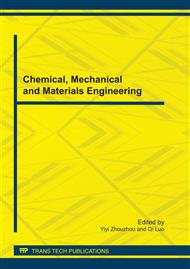p.237
p.242
p.248
p.254
p.258
p.264
p.270
p.276
p.282
Transformation Behavior of Molybdenum during Pressure Oxidation Process of Molybdenite Concentrate
Abstract:
MoS2(AR) was used to analyze molybdenum transformation behavior in the pressure oxidation process of Chile molybdenite concentrate. Amount of NaNO3, temperature and sulphuric acid concentration were investigated on the total transform rate of Mo, leaching rate of Mo and absolute transform rate of Mo in residue. ICP, XRF, XRD were used to analyze the content and phase of elements in the molybdenite concentrate and residue. Single factor experiment results of indicate that when amount of NaNO3 is 1:4, temperature is 150°C,sulphuric acid concentration is 40g/L, oxygen partial pressure is 0.8MPa, liquid to solid ratio is 6:1(ml:g), reaction time is 120min and stirring speed is 500rpm, total transform rate of Mo is 97.95%, leaching rate of Mo is 18.48% and absolute transform rate of Mo in residue is 79.47%. Synthetical condition experiment results certified this process has the preferably reproducibility. Molybdenum could be recovered sufficiently through this method.
Info:
Periodical:
Pages:
258-263
Citation:
Online since:
July 2011
Authors:
Price:
Сopyright:
© 2011 Trans Tech Publications Ltd. All Rights Reserved
Share:
Citation:


